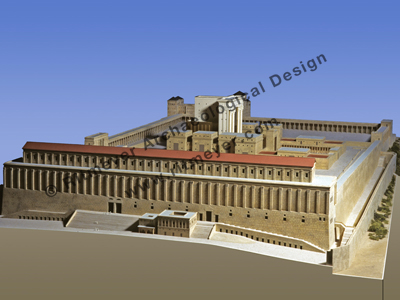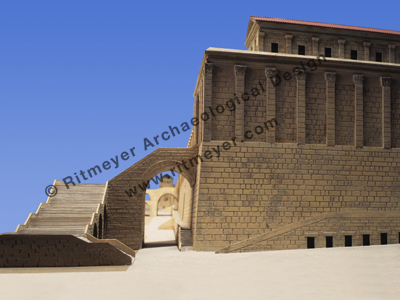Ferrell Jenkins has an interesting post on the Pinnacle of the Temple.
In my reading the most common view is that the southeast corner of the Temple Mount is the place mentioned in Mark and Luke as the pinnacle of the temple.

He aso quotes from Benjamin Mazar’s book The Mountain of the Lord:
Benjamin Mazar, The Mountain of the Lord, shows a photo of the southeast corner of the wall with the comment that this “is known as the ‘pinnacle of the Temple’ (Mark 11:11; Luke 4:9),” page 149.
Although this statement does appear in the book, I remember discussing this problem with him and he said that he actually saw the southwest corner of the Temple Mount as a more likely candidate for the pinnacle of the Temple. One needs to determine what was the most important element in the temptation of Jesus to throw himself down from the pinnacle. Was it the height of the corner above what lay below or did the temptation lie in impressing as many people as possible with that jump?

As the southwest corner was a busy junction between the major north-south street running through Jerusalem and the Plaza in front of the Southern Wall of the Temple Mount, there would have been many more people to impress here than on the much quieter southeast corner.
It is in a setting such as this that we can visualise the dramatic scene that would have taken place had not Jesus challenged the temptation with the power of God’s Word.

Was it also the place of the trumpeting, as indicated by the inscribed remnant that was found below?
Joe,
Yes, that is the same place. The reason for the location at the southwest corner was its centrality and height, so that everybody could hear the trumpet blast.
That would not have been the case at the southeast corner.
I have an interesting thought??? Could Jesus have been taken to the highest point on the temple itself (not the surrounding walls) and if so…what lies below that point? The Brazen Altar which as we know was where the sacrifices were made. With this said, then perhaps Satan was trying to have Jesus sacrifice himself prematurely, therefore thwarting God’s original plan of salvation. Just a thought provoking idea.
Only priests were allowed into the Temple building itself, so your proposition appears to be unlikely.
I have recently read a publication by the marketing department for a Bible College that was title “Why go to Bible College: Hermeneutics Saved the World.” In the article the writer uses one of their arguments for going to Bible College from Jesus 2nd temptation. While I am still perplexed and alarmed by much of what was written I am curious as to concept that Jesus 2nd temptation was intended to reveal Himself as the Messiah before the multitudes. Is this exegises of this passage relatively new?
A comment was made at our Bible Class last night that it was a Jewish tradition that Messiah would first appear to Israel at the “pinnacle of the Temple”. Alfred Edersheim (The Life and Times of Jesus the Messiah” BookII p.293) gives a quotation ;
“Our Rabbis give this tradition : In the hour when King Messiah cometh, He standeth upon the roof of the sanctuary, and proclaims to Israel, saying, ….etc”. Any comments?
John,
An interesting connection. However the point of the temptation was that, if jumping down, Jesus would not be hurt, rather than using the location of the pinnacle top announce the hour of deliverance to Israel.
It’s interesting that there is so much concern for the proper location of the pinnacle of the temple. There is also the possibility that Jesus’ experience was visionary in nature, that He did not physically move around during the temptation. In such a case, the location is insignificant compared to Jesus’ using his mastery of God’s truth to not be led astray by the devil’s trickery. There is some good support to seeing the temptation as a visionary experience. Not all of the story makes sense if it is a literal/physical experience.
Kevin,
I also believe that the temptation didn’t take place in Jerusalem, as Jesus was somewhere near the River Jordan where he had been baptised. However, he had been many times to Jerusalem before, at least once every year during Passover since he was 12, and so would have been familiar with the layout of Herod’s Temple Mount and would in his mind have known where the pinnacle was.
Is it possible to calculate the distance from the top of the southeast corner of the Temple Mount to the ground below? What would the hypothetical fall have been?
Robert,
In the Herodian period, the height of the top of the southeast corner above the street below was approx. 50m or 164 feet.
I have been doing a bit of research on this subject and I’m wondering if you might have some added insights. Josephus states the height of the southeast corner was 300 cubits (450 ft). Though he did at times exaggerate, how do we account for the approximate 300 ft difference in stating the height was 150-164 feet?
Jessica,
Josephus may have confused cubits with feet. The height from the bedrock (before the street was laid) to the top of roof of the Royal Stoa is about 250 feet, which is not too far off from 300.
Thank you! I am trying to do research on what the height would have been when Jesus stood on the pinnacle. If that was the SE corner, would the street have been laid yet? I’m confused on whether the entire complex was finished in a year and a half or if perhaps the streets and outer walls may have still been left to work on through the 46 years it took to complete the structure. I’m wondering if there is any way of determining its height during Jesus’ day.
Jessica,
The height from the top of the SE corner to the street level below would have been approx. 45m (145 ft). In about 54AD the streets were paved, although the level didn’t change much.
Thank you, Leen! I appreciate your insights on this topic.
What can we learn,from the fact that,James was thrown down this same spot,where Jesus was tempted to fall from?
Some later sources indeed relate that James was thrown down the pinnacle of the Temple, but according to the most reliable and earliest source, Josephus (Antiquities 20,200) James was stoned to death by Ananus, son of Ananus.